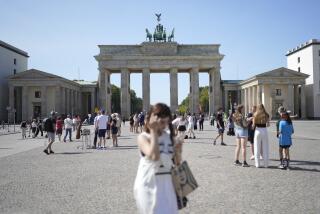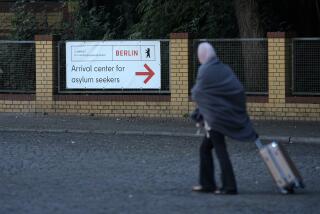Eastern Germany’s Youths Heeding the Call of West
- Share via
ROSTOCK, Germany — Desperate for work and worldly diversion, the young people of eastern Germany have resumed fleeing westward at a rate not seen since the tumultuous year after the fall of the Iron Curtain.
Cities such as Rostock have lost up to one-fifth of their population, mostly the young brains and brawn the east needs to close the prosperity gap with the west and avoid becoming a giant home for the retired.
But one man’s exodus--or woman’s, because more women than men are leaving--is another’s mobility, and many point out that the movement marks the first vital flow of energy and ideas across the vanished borders.
“Young people aren’t going away from the east, they are going toward where the jobs are,” said Ulrich Bauermeister, head of the Port Development Society. “This migration shouldn’t be seen only as a loss. It is also a welcome sign of the labor mobility and flexibility Germany has long been lacking.”
Some of modern Europe’s most prosperous nations suffered the same youthful exodus a century ago, when Irish, Scandinavians and Germans left what seemed like hopeless homelands to make their living in the United States. Few came back once they had jobs and families in the New World, but the transatlantic ties fostered what some here see as healthy circulation of money and ideas.
Rostock is only one of eastern Germany’s rapidly shrinking cities, but it has sustained the biggest proportional population falloff. This busiest of German ports was home to 248,000 people a decade ago and now has fewer than 198,000, said Claus Weitendorf, head of the Chamber of Commerce. After leveling off in the early 1990s, the exodus began picking up speed again two or three years ago, he said.
But not all of the departures reflect despair. Many of those who have left the cities did so to build houses in the serene suburbs nearby--a migration that should be seen as a sign that many are making their way up the post-Communist social ladder.
The surrounding state of Mecklenburg-West Pomerania, for example, has lost just 10% of its population during the same decade in which its two biggest cities, Rostock and Schwerin, lost 20%. Across the five states that once made up East Germany, the population shrinkage is only 6%--but even that represents the first net loss to the west in nearly a decade.
“We see this as a piece of normality. Young people are going to where they can best put their skills to use, and young families would rather live in the ‘Bacon Belt,’ ” said Deputy Mayor Karina Jens, referring to the wealthier periphery of the eastern cities.
The movement means a smaller tax base and tighter budgets for city services to those still in Rostock, she noted. But until wages and buying power grow, young professionals are better served building their careers elsewhere, she acknowledged.
Bauermeister argues that unemployment numbers--20% across the east--give a bleaker picture than the reality because almost all adult women in this region were employed before reunification, in contrast with barely half in western Germany. Industries were also grossly overstaffed, he noted. The port, for instance, now handles more freight with 2,300 employees than it did a decade ago when it had 5,700.
Fears Over Jobless Ranks
Germans often express fears that their 9% unemployment nationwide will swell if Eastern European countries to be integrated into the European Union are allowed to exercise the right to take jobs elsewhere. But Bauermeister waved off those fears as nonsense.
“We’ve had Turkish guest workers coming here in droves since the 1960s, and the Poles also have been working here since forever,” he said. “An exchange of labor force is dynamic. Sure, people want to find jobs where they grew up, but this mobility is part of what is needed to make Europe whole again.”
Rainer Dinkel, a professor of demographics at the University of Rostock, agrees that mobility is necessary. But he finds the degree to which the east is being drained of its youthful resources alarming.
“It’s not so much the numbers as the age groups,” he said. “It’s all young people between 16 and 30, and mostly women. Five percent of the women in this group have left in each of the last couple of years, and if this trend lasts for a decade, that will be half of the young female population.”
Without some signal from the government in Berlin, such as encouraging a major employer to move here, the average age of the population will grow rapidly and put a staggering weight on pension and health-care systems, he said.
Ulrich Seidel, a native of the eastern island of Ruegen and head of the Rostock Entrepreneurs Assn., said he sees the exodus as a natural reaction to the weak job market here, one that is good for the economy in general even if it is difficult on the individuals who feel compelled to leave. But risking joblessness is far more dangerous, he argued.
“Unemployment is so emotionally destructive. It’s much better for someone to take a job elsewhere, leaving friends and family, than to risk falling into idleness and being a burden on the state,” said the businessman, whose two daughters have taken jobs in Berlin and the northwestern city of Bremen.
What the east most urgently needs, he said, is some hope that the job market will get better, so that those now leaving don’t rule out returning.
A lack of hope for near-term improvement is behind the worrisome statistics compiled by social researcher Karl-Otto Richter, who said three-quarters of high school students expect to move west.
“One-quarter really want to, but the others say they see no other options,” Richter said. “What’s tragic is that this is a forced migration.”
Projections that eastern states such as Mecklenburg-West Pomerania could soon be peopled only by the very old aren’t threats but are realities, the researcher said.
“No one needs to fear this place becoming the old folks’ home of Germany, because it already is,” he said.
With a scenic coastline and the sparsest population in the country--1.7 million residents across 9,000 square miles--the state should focus its hospitals on care of the elderly and support cottage industries such as handicrafts and bed and breakfasts that can employ those at the end of their working years, Richter said.
Others who have endured the changes of the past decade say people here are tired of having to reinvent themselves and would rather just leave.
“People’s values have been completely destroyed,” evangelical pastor Arvid Schnauer said. “We see children here who have mobile phones but not enough to eat. It’s no wonder they feel no hope for the future.”
But Susanne Prill, a social worker who recently returned after several years’ absence, said she expects the emigrants to trickle back over time.
“Some things in the east are still better--like child care,” said the 36-year-old working mother. “You can find a place so much more easily here, and it’s good-quality care for less money.”
For those in their teens, that may be of little importance.
“Nothing ever happens here. I want to move as soon as I finish high school,” 15-year-old Mareen Kalle said as she hung out at a newly built youth center. “My parents want me to go to Frankfurt or Berlin--they know I won’t have many opportunities here.”
Housing Is Now Cheaper
One positive side effect of the exodus is the ease with which young people staying behind can now find affordable housing. Christian Evert is only 16 but expects to get a small place next year in the same complex where he lives with his mother. “There’s not much work here, but this is where my friends are,” said the youth.
Elementary school teacher Christina Molle said she sees the biggest problem here as one of perception.
“People here only compare themselves to the west, never with the east, where conditions are still far worse than what we have,” she said. “We have accomplished a lot more than we realize.”
A stroll through Rostock’s Old Town is one graphic reminder of the huge investment of money and muscle applied here. Medieval monuments, quaint cobblestone streets and pastel-colored baroque houses have been restored to the splendor of previous centuries. New restaurants, shops and services splash color and commerce throughout the city, and tourism along the Baltic Sea coast is enjoying a revival.
“The real disaster would be if people here forget what it was like in East Germany,” said Seidel of the entrepreneurs group. “We need to take a peek over the border to Russia more often. These were our brothers in socialism’s struggle, and we should realize just how lucky we are to be where we are.”
More to Read
Sign up for Essential California
The most important California stories and recommendations in your inbox every morning.
You may occasionally receive promotional content from the Los Angeles Times.














